Water-based polyurethane takes around 6-8 hours to dry between coats and around 24 hours to cure (fully dry). Oil-based polyurethane takes around 24 hours to dry between coats and 48-72 hours to fully cure (harden).
Factors that determine the polyurethane dry time include sealer type, environmental conditions, and coat thickness.
To speed up polyurethane drying time, apply thin coats, use a hairdryer, lower room humidity, or allow proper room ventilation.
The evaporation rate increases as you increase the temperature, according to 5th Grade – Lesson 1.4 The Water Cycle Teacher Background of American Chemical Society (ACS).
| Polyurethane Type | Re-coat Time |
|---|---|
| Water-based | 6-8 hours |
| Oil-based | 24 hours |
| High Gloss Sheen | Slightly longer than satin or semi-gloss finishes |
| Satin Sheen | Varies, typically within 6-8 hours of drying time |
| Semi-Gloss Sheen | Varies, typically within 6-8 hours of drying time |
| Fast-drying | 4-6 hours |
Key Takeaways
- Water-based polyurethane dries in 8 hours, and cures in 24 hours.
- Oil-based polyurethane dries in 24 hours, and cures in 48-72 hours.
- Factors affecting drying time: temperature, humidity, coat thickness, airflow.
- Methods to speed up drying: apply thin coats, increase temperature, use a hairdryer (max 5 minutes), lower room humidity, and ensure proper ventilation.
How Long Does Polyurethane Take to Dry Between Coats?
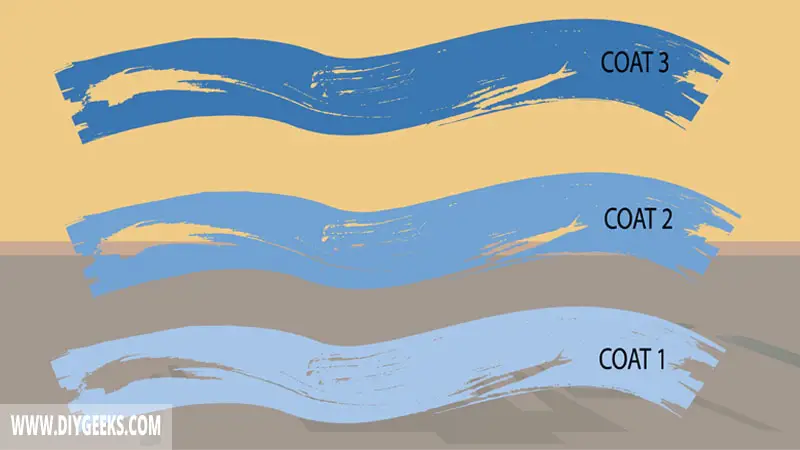
It takes water-polyurethane 6-8 hours to dry between coats, while oil-based polyurethane needs 24 hours to dry enough for a re-coat.
It takes fast-drying polyurethane 4-6 hours to dry between coats, according to Minwax.
For a coating to dry enough for a re-coat, its solvent (water or oil) must evaporate fully and the coating must become hard.
Since water-based polyurethane uses water as its solvent and oil-based polyurethane uses synthetic or natural oil as its solvent, they have different drying times. Since water evaporates faster than oil, it means water-based polyurethane dries faster.
Different finishes (or sheen types) of polyurethane have different drying times. For example, satin polyurethane dries faster than high-gloss polyurethane even if both sealers have the same solvent (or base). That’s because the satin finish has fewer additives and gloss in its formula, which decreases the drying time.
Polyurethane drying time refers to the time it takes for a coating to dry and become hard enough to support the next coating.
What Happens If You Re-coat Polyurethane Too Soon?
If you re-coat polyurethane too soon, the coatings will have poor adhesion, longer dry time, color blending issues, reduced durability, and will turn sticky (or remain wet for too long). This results in an uneven, blurry, tacky, and weak finish for several days. In some cases, polyurethane can peel off the surface.
If you re-coat before the solvent evaporates from the coating, the evaporation process will be halted and the solvent (water or oil) will remain trapped between two coats and prevent the next coats from adhering properly.
The trapped solvent can bleed through, causing color differentiations and uneven drying times when the next coating is applied. This is more noticeable when re-coating over tinted polyurethane.
To ensure a durable, moisture-resistant, and glossy polyurethane finish, allow enough drying time between polyurethane coats.
How Long Does Polyurethane Take to Cure?
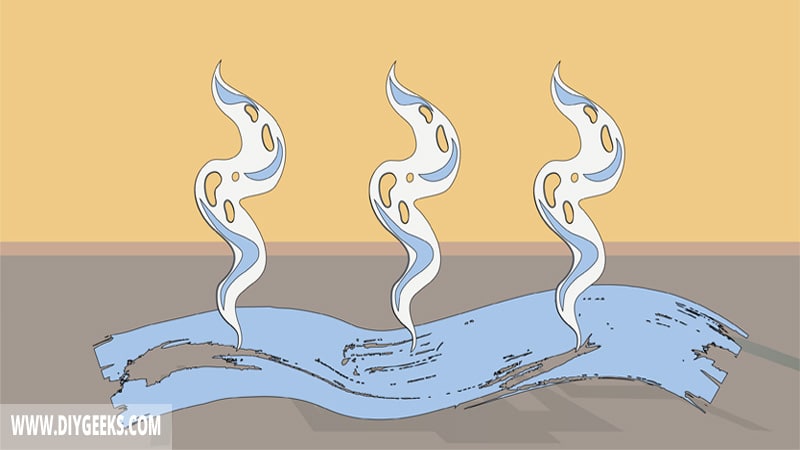
Water-based polyurethane takes 24 hours to cure (fully dry), while oil-based polyurethane takes 48 hours to dry. The curing time refers to the duration it takes for the coating to become hard, glossy, moisture-resistant, and UV-resistant.
There’s a difference between coating drying and curing. Drying refers to the process by which the solvent evaporates from the coating, causing it to be semi-hard and touch-dry.
Curing refers to the process by which the particles bond together and harden over time, resulting in a fully cured, durable, and moisture-resistant finish.
After the coating cures, it goes through a process called Cross-linking. Cross-linking is “fundamental for obtaining a durable film that keeps the pigment particles together and adherent to the support”, according to ACS Applied Polymer Materials 2021 3 (4), 1912-1922.
During evaporation, the solvent (water or oil) evaporates and the coating dries. During curing, the solvent particles react with the oxygen in the atmosphere, causing the particles to harden and bond together.
Factors Affecting Drying and Curing Time
Factors that affect the during and curing time of polyurethane are listed below.
- Type of The Sealer. The type of polyurethane affects the drying time. For example, oil-based polyurethane dries slower because it uses synthetic oil as its solvent. Synthetic oil evaporates slower than water, which results in a slower dry time. Also, some types have drying agents, more pigments, or extra solvents that can affect the drying time.
- Environmental Conditions. Factors like room temperature and humidity determine the evaporation rate. Higher temperatures and lower humidity lead to faster drying time. While the opposite, low temperature and high humidity, lead to slower drying and curing time.
- Coat Thickness. The thicker the coat is, the longer it takes to dry. That’s because a thick coat has more solvent to evaporate. It’s recommended to apply thin coats.
- Wood Species (if applicable). In specific cases, specific wood (or surface) types, such as rosewood and aromatic cedar, may contain natural oils or compounds that can affect the solvent drying time. These oils can slow the evaporation of the solvent and coat drying.
How To Speed Up Polyurethane Dry Time?
To speed up the polyurethane drying time, do the following things.
- Apply Thin Coats.
- Use a Hairdryer.
- Lower Room Humidity.
- Allow Proper Room Ventilation.
1. Apply Thin Coats
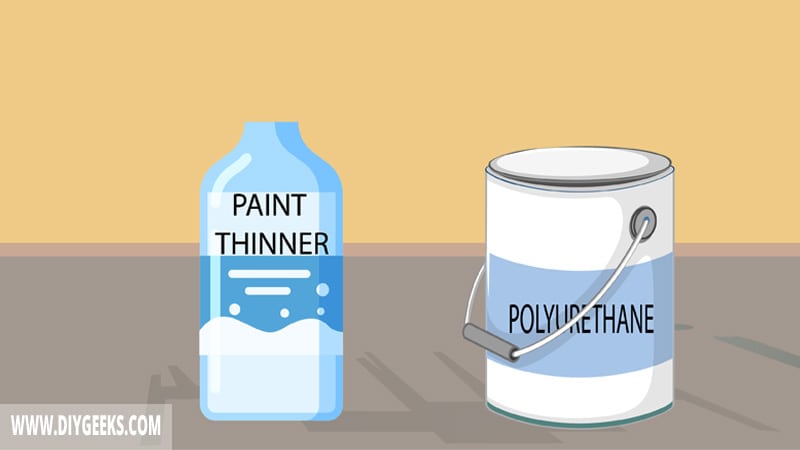
To speed up the drying time, apply thin coats as they dry faster than thick coats. To thin water-based polyurethane use water, to thin oil-based polyurethane use mineral spirits or turpentine.
Use a thinning ratio of 1:4 (1 part thinner to 4 parts polyurethane) for spraying, and a ratio of 1:3 (1 part thinner to 3 parts polyurethane) for brush or roller application.
2. Use a Hairdryer
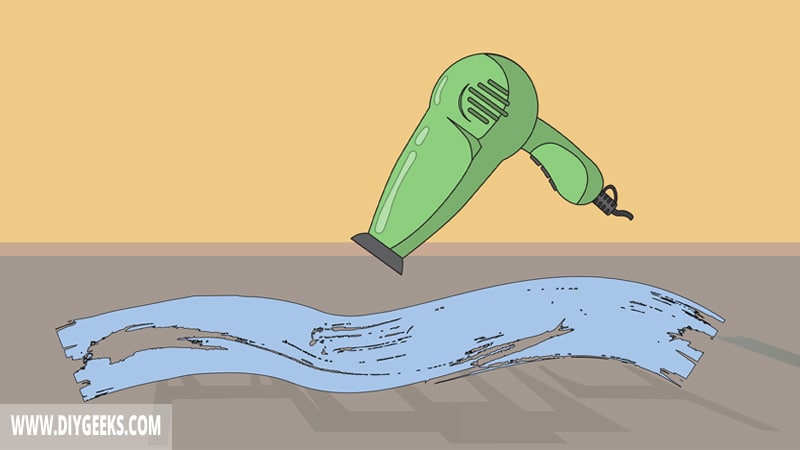
Since polyurethane dries through evaporation, increasing the temperature around the coating will increase the evaporation rate.
Use a hairdryer to increase the evaporation rate. Set it to medium heat and keep it 8 inches away from the coating. Move it from side to side to avoid drying the finish unevenly. Only use it for a maximum of 5 minutes.
Note: Don’t fully dry the coating using a hairdryer, as it can cause the finish to peel off. Exposing the coating to increased heat will make the particles harden too quickly, which results in poor bonding and reduced durability of the finish.
3. Lower Room Humidity
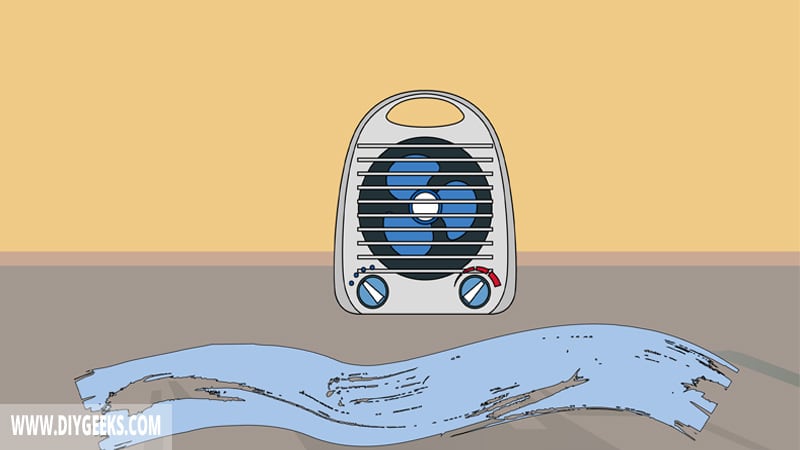
Reduce the moisture content in the room to accelerate the drying time. If the moisture content exceeds 50%, the polyurethane will dry slower as its solvent will evaporate slower. To lower the moisture content, use a dehumidifier.
To lower room humidity do the following things.
- Turn On The Dehumidifier – The dehumidifier will draw in air, condense (or remove) the moisture in the air, and release dry air into the atmosphere. This decreases the moisture content and helps the solvent to evaporate faster.
- Keep The Dehumidifier Running – You can keep the dehumidifier running for hours. The longer the dehumidifier works, the lower the moisture content will be, and the faster the sealer will dry.
4. Allow Proper Room Ventilation
Open all windows and doors before applying polyurethane to get proper air circulation. Improved airflow increases the evaporation and oxidization rate, which speeds up the drying time.
Additional Tips for Faster Drying:
- Use water-based polyurethane because it dries faster.
- Apply the coating early in the day before temperatures rise.
- Use fans to increase air circulation in the room.
- Turn on the fans in the room to increase air circulation.
- Apply it in proper painting conditions. Humidity should be less than 50%, and temperature should be between 50-80 degrees (F).
How To Know If The Polyurethane Coating Is Dry?
To know if the polyurethane coating is dry, assess its texture. If it’s wet or tacky, the finish hasn’t dried yet. If the finish is shiny and reflective, it has dried.
You can also use the nail test to know if the finish is hard and dry enough. Run your nail across the coating; if polyurethane accumulates in your nail, the finish isn’t dry. If it doesn’t accumulate, the finish is dry.
Additionally, you can use sandpaper to test the dryness and hardness of the finish. Swipe the sandpaper across the coating; if it clogs up, the finish isn’t dry. If the sandpaper moves freely without clogging, the coating is dry.
How Many Coats of Polyurethane Do You Need?
You need 2-5 coats of polyurethane depending on the surface type.
For indoor surfaces that don’t need much protection, 2-3 coats are enough. For outdoor surfaces that are exposed to weather elements, you need 3-5 coats.
Should You Sand Between Coats of Polyurethane?
You should sand between coats of polyurethane to remove any dust, dirt, or brush marks from the coating.
If you don’t sand between coats, the dust or dirt will prevent the next coating from adhering properly.


